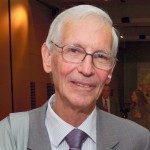Link to Pubmed [PMID] – 10790372
EMBO J. 2000 May;19(9):2056-68
The transcription factor AP-1, composed of Jun and Fos proteins, is a major target of mitogen-activated signal transduction pathways. However, little is known about AP-1 function in normal cycling cells. Here we report that the quantity and the phosphorylation state of the c-Jun and JunB proteins vary at the M-G(1) transition. Phosphorylation of JunB by the p34(cdc2)-cyclin B kinase is associated with lower JunB protein levels in mitotic and early G(1) cells. In contrast, c-Jun levels remain constant while the protein undergoes N-terminal phosphorylation, increasing its transactivation potential. Since JunB represses and c-Jun activates the cyclin D1 promoter, these modifications of AP-1 activity during the M-G(1) transition could provide an impetus for G(1) progression by a temporal increase in cyclin D1 transcription. These findings constitute a novel example of a reciprocal connection between transcription factors and the cell cycle machinery.
